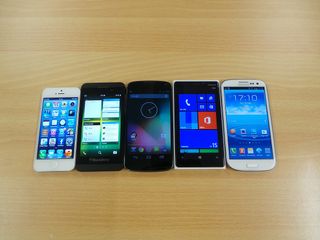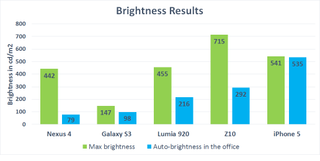Nexus 4 vs iPhone 5 vs S3 vs Lumia 920 vs BB Z10 head-to-head review
We put the best devices from Apple, BlackBerry, LG, Nokia and Samsung head-to-head.
All our devices on test have different sized displays ranging from 4ins to 4.8ins in sizes. We found colour replication and responsiveness on the handsets to be excellent across the board. We've focused on testing the brightness, as this is a good functional indicator of readability and picture quality, especially under bright office lighting. There is also a marked difference in brightness between the devices.

At a glance we can see that the Nexus 4 (centre) looks to be the least bright. Do the numbers back this up?

BB Z10 4.2in (1280 x 768)
The BlackBerry Z10 gave the brightest reading on test by far, with an eye-scorching maximum reading of 715cd/m2. There is no way to turn off the automatic brightness setting so the device is always adjusting itself based on the ambient light. During indoor usage in the office we found the brightness reading to be around the 300 cd/m2 mark, which is still brighter than most of the competition.
iPhone 5 4in (1136 x 640)
The small screen combined with the high 1366 x 640 resolution makes this the sharpest display on the market. Apple devices usually have a high brightness reading and the iPhone 5 delivered the highest readings consistently. It gave a max brightness of 582cd/m2, which is only bettered by the BlackBerry. When set auto-brightness was turned on, the device was the brightest of all those on test by far.
Lumia 920 - 4.5in (1280 x 768)
Get the ITPro. daily newsletter
Receive our latest news, industry updates, featured resources and more. Sign up today to receive our FREE report on AI cyber crime & security - newly updated for 2024.
A solid third place for the Lumia 920. The 4.5in IPS display is bang in the middle when it comes to size and brightness. The device registered a maximum brightness 427cd/m2, so it won't blow the iPhone or BlackBerry out of the water.
Nexus 4 - 4.7in (1280 x 768)
Although the maximum brightness on the Nexus is up there with the likes of the iPhone 5 with a reading of 442cd/m2, leaving the auto-brightness on can result in a poor user experience. We measured brightness at just 76cd/m2 in our brightly lit office environment when leaving auto-brightness on.
Galaxy S3 - 4.8ins (1280 x 800)
It may look like it's in last place with a max brightness of just 147cd/m2, but the Super Amoled technology helps to compensate for this. The OLED pixel helps to display vibrant colours and contrast ratio is better than LCD panels. This allows the the Samsung display to appear brighter than it actually is. The S3 also has built-in controls which does let you tinker with the colour temperature and contrast to alter the display.
Winner: Draw
Pixel-for-pixel we'd give the nod to the iPhone 5. The Retina Display is the clearest and consistently the brightest handset. However, it does have the smallest display so if you want a larger screen we'd recommend the Galaxy S3 as the Super Amoled display is excellent.




